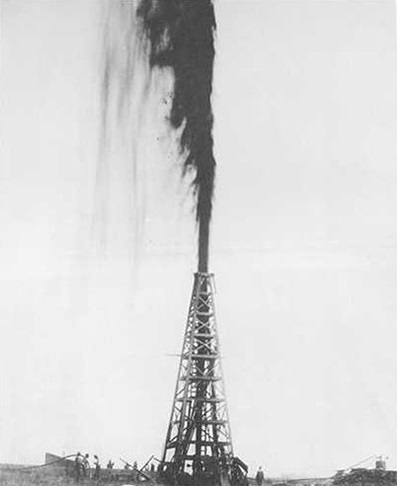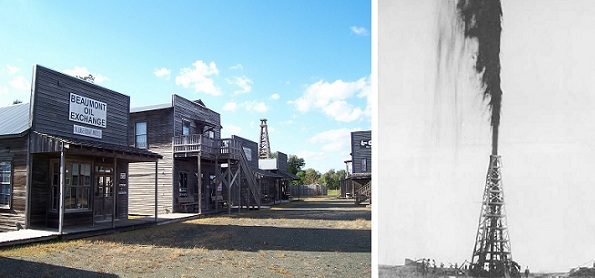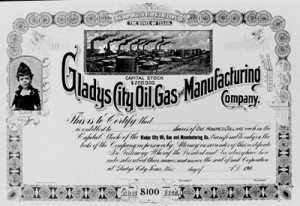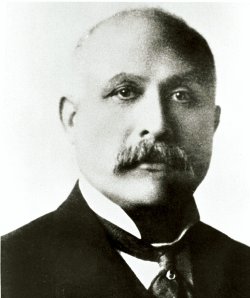Giant Texas oilfield discovery in 1901 coincided with gasoline demand for automobiles.
On January 10, 1901, the “Lucas Gusher” on a small hill in Texas revealed the Spindletop oilfield, which would produce more oil in a single day than the rest of the world’s oilfields combined.
Although the 1899 Galveston hurricane (still the deadliest hurricane in U.S. history) brought great misery to southeastern Texas as the 20th century dawned, a giant oilfield discovery three miles south of Beaumont launched the modern oil and natural gas industry.

The January 10, 1901, “Lucas Gusher” was the first U.S. well to produce 100,000 barrels of oil per day. At right, Anthony F. Lucas stands by his well in this photo by Frank Trost of Port Arthur, Texas.
“Dubbed ‘The Lucas Gusher,’ the oil discovery on Spindletop Hill changed the economy of Texas,” helping to usher in the petroleum age, according to the Spindletop-Gladys City Boomtown Museum in Beaumont.
Drilled by Capt. Anthony Lucas, Curt Hamill, and two experienced Pennsylvanians, the well erupted oil for more than a week before it could be brought under control with the limited technologies of the day. Production from the giant oilfield came from what proved to be a salt dome geologic formation.

Spindletop-Gladys City Boomtown Museum in Beaumont, Texas, tells the story of the 1901 oilfield that helped make the United States a world power. Photo by Bruce Wells.
Beaumont’s oil museum, dedicated at Lamar University in 1976, preserves the giant field’s history with hundreds of indoor and outdoor exhibits — including a 16-building replica of Gladys City and a 100-foot derrick that can gush a column of water for two minutes.
Museum tours led by volunteer docents explain how drilling at a geologic salt dome created an oil boom far exceeding America’s first oil discovery in 1859 in Pennsylvania. The discovery at Spindletop Hill in Texas arrived at a key time for the U.S. petroleum industry.
As consumers replaced their kerosene lamps in favor of electricity, they would soon want far more of another refined petroleum product, gasoline for their automobiles (the first U.S. auto show was held in New York City two months before the Spindletop gusher).
Petroleum companies would soon be pumping gasoline into automobiles from “filling stations” across the country, especially as roads improved with asphalt paving the way.

“Spindletop Viewing Her Gusher,” pastel on linen, 1913, by Aaron Arion, once welcomed guests at the Dixie Hotel in Beaumont, Texas.
According to the museum, Texaco and Gulf got their start in the Beaumont area oilfields. Humble — now ExxonMobil — began at the nearby town of Humble (learn more in Oil Reigns at King Ranch).
The size of the 1901 discovery near the southeastern Texas Gulf Coast defied all predictions. Also known as the “Lucas Gusher” after Captain Anthony F. Lucas, a mining engineer “who drilled on a hill,” the oilfield produced 3.59 million barrels in its first year and an incredible 17.4 million barrels the next.
In addition to advancing the science of petroleum geology (see Rocky Beginnings of Petroleum Geology), the Spindletop field’s oil production helped end John D. Rockefeller’s eastern monopolies in transportation and refining.

“Christmas trees” to control oil wells became commonplace after the Spindletop gusher. The Texas discovery “changed the way people would live all over the world,” noted Michel T. Halbouty in 1952. Photo by Bruce Wells.
In 1936 — fifteen years after Lucas died — the American Institute of Mining, Metallurgical, and Petroleum Engineers (founded in 1871) began awarding an Anthony F. Lucas Medal. The award recognizes “distinguished achievements in improving the technique and practice of finding and producing petroleum.”
Spindletop created the modern oil and natural gas industry and changed the future of American manufacturing and transportation. The oilfield discovery also helped popularize rotary drilling technologies and the other exploration and production methods.
Meanwhile, in 1903 the city of Beaumont fielded its first minor league baseball team, the Beaumont Oil Gushers of the South Texas League.
Prophet of Spindletop
The story of the Spindletop oilfield’s discovery well began more than a decade earlier when the Gladys City Oil, Gas & Manufacturing Company was formed by Patillo Higgins. Higgins, a one-armed mechanic and self-taught geologist, was one of the few at the time who believed U.S. industries would soon switch fuels from coal to oil (see Petroleum and Sea Power).

The Spindletop-Gladys City Boomtown Museum in Beaumont, Texas, tells the story of one the greatest U.S. petroleum discoveries, the “Lucas Gusher” of 1901. The Spindletop field produced more oil in one day than the rest of the world’s oilfields combined.
Higgins is convinced that the “Big Hill” four miles south of Beaumont has oil — despite conventional wisdom to the contrary. Through the latter half of the 19th century, Pennsylvania remained the most oil-productive state in the country as new technologies for increasing oil production, including “shooting” wells with explosives.
Texas had produced only minor amounts of oil, starting in 1866 with the first Lone Star oil well drilled by Lyne Taliaferro Barret near the East Texas town of Nacogdoches.

Patillo Higgins formed the Gladys City Oil, Gas & Manufacturing Company on August 24, 1892.
Formed over millions of years, the hill near Beaumont resulted from a massive underground dome of salt that eventually moved nearer the surface. Higgins believed drilling a well on top of this salt dome would produce oil, but Texas newspapers and the state’s geologists scorned him (learn more in Prophet of Spindletop).
Nobody believed a salt dome structure would be productive, especially after the Gladys City Oil, Gas & Manufacturing Company drilled unsuccessful wells on Spindletop in 1893, 1895 and 1896. Higgins would leave his own venture — but he hired a Croatian mining engineer before he left.
“Lucas Gusher” of 1901
Anthony Lucas (Antun Lucic, born in 1855). Lucas studied at the Polytechnic Institute in Graz, Austria, served as a captain in the Austrian navy, and had been a salt miner in Louisiana.
I went to Beaumont, Texas, about seventy miles west of Lafayette. There I was attracted by an elevation, then known locally as Big Hill, although this hill amounted merely to a mound rising only twelve feet above the level of the prairie. This mound attracted my attention on account of its contour, which indicated possibilities for an incipient dome below, and because at the apex of it there were exudations of sulphuretted hydrogen gas. — Capt. Lucas quote from Interviews with Mining Engineers by Thomas Arthur Rickard, 1922.
Lucas contacted famed Pennsylvania oilman John Galey and his partner James Guffey, who had drilled marginally successful wells in nearby Corsicana in 1896. Galey and Guffey returned to Pennsylvania unconvinced there was a future for oil in Texas. Galey would have a change of heart.
Three years later, the veteran independent producer returned to Beaumont to survey the area. Galey picked a spot at Spindletop Hill, and the drilling began on October 27, 1900.

Technological advances from drilling at Spindletop “paved the way for other oil producing states like California to increase their production.” Early major oil companies like Texaco, Gulf, Mobile, Humble and Sun Oil trace their roots to the “Big Hill.”
The well proved difficult at the very beginning. With little hard rock at the surface, the drillers had to find ways to drill through several hundred feet of sand, which made the hole prone to caving. To help solve this problem, one of Lucas’s drillers, Curt Hamill, came up with a solution revolutionary at the time, according to the Paleontological Research Institution (PRI).
Instead of pumping water down the hole to flush out the cuttings produced by the action of the drill, Hamill used mud. This helped in retrieving the well’s cuttings.
Equally important, drillers learned how mud stuck to the sides of the hole and kept it from caving. Drilling mud mixtures have been used in wells worldwide ever since.

“On this spot on the tenth day of the twentieth century a new era in civilization began,” notes an inscription on the 25-foot-tall monument dedicated in 1941 — and today part of the Spindletop-Gladys City Boomtown Museum’s outdoor exhibits. Photo by Bruce Wells.
The “Lucas Gusher” would erupt more than 150 feet into the air after reaching a depth of 1,139 feet. It began flowing at an astounding 100,000 barrels per day.
25 Cents a Barrel
Another Spindletop petroleum geologic milestone: the well was the first significant discovery of prolific salt dome structures along the Gulf Coast (and offshore).
With oilfield technologies still evolving, the Lucas well’s pressure could not brought under control for nine days, losing an estimated 850,000 barrels of oil. A new device — now called a “Christmas Tree” — would be used to control the flow of Spindletop’s oil. Effective technology for preventing well blowouts would be invented at a Humble, Texas, workshop and patented in 1926.
In its first year Spindletop produced 3.59 million barrels of oil, climbing to 17.4 million by its second year. Texaco, Gulf, Mobile, Humble and Sun Oil can trace their roots to the “Big Hill” — but the oilfield’s huge reserves caused prices to drop from $2 per barrel of oil to less than 25 cents a barrel.
As fishtail drilling bits gave way to coned, rotary bits as petroleum engineering pioneers in California and Texas (see Carl Baker and Howard Hughes) led the way for other oil-producing states. Service companies for the exploration and production industry were beginning to converge on Bakersfield, Houston — and the Oklahoma “oil capital” of Tulsa.
The Spindletop discovery affected the entire world, according to Michel T. Halbouty (1909-2004), the respected Houston oil producer and historian who in 1952 co-authored Spindletop: The True Story of the Oil Discovery that Changed the World.
“It revived the industrial revolution, which had been dead for a while. It caused the United States to become a world power. It revolutionized transportation through the automobile industry,” Halbouty explained. “It started the Liquid Fuel Age, the greatest age in the history of the world.”
In addition to the Spindletop-Gladys City Boomtown Museum, the Texas Energy Museum in Beaumont tells the story of the Spindletop discovery — and the role of petroleum in America’s economic development.
_______________________
Recommended Reading: Spindletop: The True Story of the Oil Discovery that Changed the World (1952); Giant Under the Hill: A History of the Spindletop Oil Discovery (2008); Texaco’s Port Arthur Works, A Legacy of Spindletop and Sour Lake (2003); Early Texas Oil: A Photographic History, 1866-1936
(2000); Trek of the Oil Finders: A History of Exploration for Petroleum (1975) . Your Amazon purchase benefits the American Oil & Gas Historical Society. As an Amazon Associate, AOGHS earns a commission from qualifying purchases.
_______________________
The American Oil & Gas Historical Society (AOGHS) preserves U.S. petroleum history. Please become an AOGHS annual supporter and help maintain this energy education website and expand historical research. For more information, contact bawells@aoghs.org. Copyright © 2025 Bruce A. Wells. All rights reserved.
Citation Information – Article Title: “Spindletop launches Modern Petroleum Industry.” Authors: B.A. Wells and K.L. Wells. Website Name: American Oil & Gas Historical Society. URL: https://aoghs.org/petroleum-pioneers/spindletop-launches-modern-oil-industry. Last Updated: January 2, 2025. Original Published Date: December 31, 2009.




